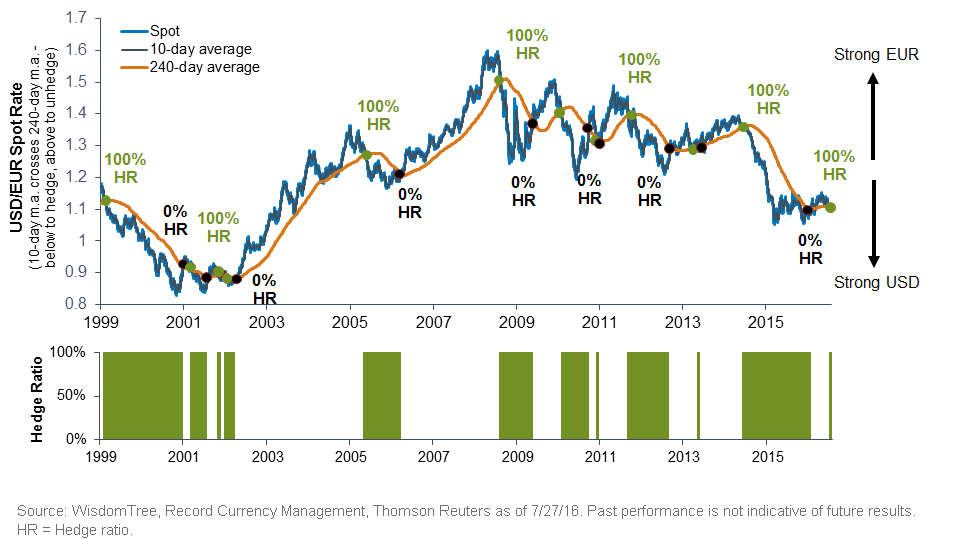Why We Just Raised Our Euro FX Hedge Ratio Dynamically


 The Added Value of Dynamic Signals
Our research, conducted in conjunction with Record Currency Management, has shown that this dynamic model could add value compared to both hedged and unhedged approaches over the long run. We expect that the dynamic hedging model could add anywhere between 100 to 200 bps per year compared to unhedged or fully hedged options for the euro.
The two strongest factors in our research were interest rates and momentum. These both now suggest that one should be hedged on the euro and that the hedge ratio just increased as of our latest signal for July’s month-end.
Just as smart beta and factor models are designed to add excess returns to the equity process, our dynamic hedging model is designed to increase returns by adding hedges when they are expected to be more profitable.
How to Incorporate Dynamic Hedging in Portfolios
The early investors’ interest in dynamic hedging has come in our broad-based international strategy, the WisdomTree Dynamic Currency Hedged International Equity Fund (DDWM). We have argued this is the future of international equity investing, because investors often want to let their portfolio managers make the hedge/no-hedge decision. While it might be easier for investors to form a view on a single currency like the euro, we also see a case for having the dynamic euro-hedged strategy. The WisdomTree Dynamic Currency Hedged Europe Equity Fund (DDEZ) can help investors implement a dynamic hedge ratio for the euro area equity markets.
The Added Value of Dynamic Signals
Our research, conducted in conjunction with Record Currency Management, has shown that this dynamic model could add value compared to both hedged and unhedged approaches over the long run. We expect that the dynamic hedging model could add anywhere between 100 to 200 bps per year compared to unhedged or fully hedged options for the euro.
The two strongest factors in our research were interest rates and momentum. These both now suggest that one should be hedged on the euro and that the hedge ratio just increased as of our latest signal for July’s month-end.
Just as smart beta and factor models are designed to add excess returns to the equity process, our dynamic hedging model is designed to increase returns by adding hedges when they are expected to be more profitable.
How to Incorporate Dynamic Hedging in Portfolios
The early investors’ interest in dynamic hedging has come in our broad-based international strategy, the WisdomTree Dynamic Currency Hedged International Equity Fund (DDWM). We have argued this is the future of international equity investing, because investors often want to let their portfolio managers make the hedge/no-hedge decision. While it might be easier for investors to form a view on a single currency like the euro, we also see a case for having the dynamic euro-hedged strategy. The WisdomTree Dynamic Currency Hedged Europe Equity Fund (DDEZ) can help investors implement a dynamic hedge ratio for the euro area equity markets.
Important Risks Related to this Article
There are risks associated with investing, including possible loss of principal. Foreign investing involves special risks, such as risk of loss from currency fluctuation or political or economic uncertainty. The Funds invest in derivatives in seeking to obtain a dynamic currency-hedge exposure. Derivative investments can be volatile, and these investments may be less liquid than other securities, and more sensitive to the effects of varied economic conditions. Derivatives used by the Funds may not perform as intended. Funds that have exposure to one or more sectors may be more vulnerable to any single economic or regulatory development. This may result in greater share price volatility. The composition of the Indexes underlying the Funds is heavily dependent on quantitative models and data from one or more third parties, and the Indexes may not perform as intended. Each Fund invests in the securities included in, or representative of, its Index regardless of their investment merit, and the Fund does not attempt to outperform its Index or take defensive positions in declining markets. Please read each Fund’s prospectus for specific details regarding each Fund’s risk profile.
No WisdomTree Fund is sponsored, endorsed, sold or promoted by Record Currency Management (“Record”). Record has licensed certain rights to WisdomTree Investments, Inc., as the index provider to the applicable WisdomTree Funds, and Record is providing no investment advice to any WisdomTree Fund or its advisors. Record makes no representation or warranty, expressed or implied, to the owners of any WisdomTree Fund regarding any associated risks or the advisability of investing in any WisdomTree Fund.

Jeremy Schwartz has served as our Global Chief Investment Officer since November 2021 and leads WisdomTree’s investment strategy team in the construction of WisdomTree’s equity Indexes, quantitative active strategies and multi-asset Model Portfolios. Jeremy joined WisdomTree in May 2005 as a Senior Analyst, adding Deputy Director of Research to his responsibilities in February 2007. He served as Director of Research from October 2008 to October 2018 and as Global Head of Research from November 2018 to November 2021. Before joining WisdomTree, he was a head research assistant for Professor Jeremy Siegel and, in 2022, became his co-author on the sixth edition of the book Stocks for the Long Run. Jeremy is also co-author of the Financial Analysts Journal paper “What Happened to the Original Stocks in the S&P 500?” He received his B.S. in economics from The Wharton School of the University of Pennsylvania and hosts the Wharton Business Radio program Behind the Markets on SiriusXM 132. Jeremy is a member of the CFA Society of Philadelphia.

